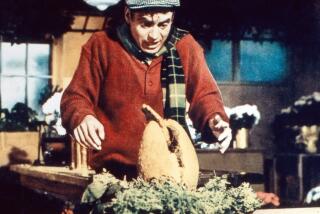Outdoors : System Is for the Birds : Protected Cormorants Putting a Dent in Fish at Local Lakes and Hatcheries
- Share via
Who is the best fisherman at your local reservoir?
Chances are, it’s not the lake regular or even the resident pro.
More likely, it’s the ever-present and ever-so-persistent double-crested cormorant, which has both the private and public fishing sectors trying to figure out ways to deal with what has become such a voracious competitor for their fish.
Hell-divers, these prolific feeders are sometimes called, and to hell is where most fishermen would like to see them go.
“Cormorants are a very much-disliked bird up here,” says Lyle Lape, who manages the marina at Santa Barbara County’s Lake Cachuma.
Why?
Because the cormorant is downright selfish. It makes a mockery of the words legal limit , gorging on trout, small catfish or anything else it can catch.
It will dive beside a boat and relentlessly chase down a school of fish. Those it can’t swallow underwater are brought to the surface, where they are flipped up and swallowed headfirst.
Then it’s back under for another chase, and another stomach full.
Lape has watched cormorants feed on the lake’s freshly stocked trout, then go after a hooked fish being reeled to shore.
“It will try to steal the fish from the fisherman, and if he’s not careful, it will,” Lape says. “We feed them well up here.”
Collectively, the birds will work as a team to clean out an entire section of the lake, herding the fish away from the fishermen and into the coves, where they can’t escape, then devouring the entire school.
“It’s too bad you can’t kill them, because within the next couple of years, they’re going to be a detriment to most of the lakes in this area,” says Ron Lindblom, a fisherman and tournament organizer at Puddingstone Reservoir. “They’re going to clean out the fish.”
The federally protected cormorant has already done that at many of the Southland’s hatcheries, whose purpose it is to supply catfish and trout to Southern California reservoirs.
“They’re kicking our butts up here,” says fisheries culturist Bud Whelchel, who works at the DFG’s Imperial County warm-water hatchery in Niland. “If (cormorants) don’t get the fish here, they’re apparently getting them where we plant them, and that’s not good.”
The warm-water hatchery raises catfish, chiefly for eventual stocking in the DFG’s Region 5, which includes reservoirs from Santa Barbara to the Mexican border.
But more recently, the department’s efforts have served merely to feed the always-hungry cormorants and pelicans that frequent the hatchery, whose one- to five-acre catfish ponds are considered too costly to cover and effectively aerate.
“But it’s not like we’re just sitting around scratching our heads,” Whelchel says. “I would estimate that we spent about $20,000 this year on cracker shells (explosive charges fired near the birds to scare them away). . . . We hired a couple of guys specifically to drive around the hatchery to fire cracker shells, honk the horn--you name it--throw rocks, use slingshots . . . and we still had that kind of a loss.”
The loss is significant, according to hatchery manager Wayne Parker.
“(Cormorants and pelicans) have cleaned me out now two years in a row, and they cleaned one (nearby) commercial hatchery out a year ago and almost totally this year,” he says. “We had one hatchery over here put 600,000 sub-yearlings out (into raising ponds) a year ago last fall, and as of March last year, it had less than 100 left.
Several lakes will have their usual allotments either restricted or canceled unless the DFG can work out cost-effective deals with some of the private hatcheries in other parts of the state.
“That’s the way it is, and the birds are all protected because they are native birds, and until they find a solution or the birds die back (to lower levels) from starvation, (hatchery officials) are going to have to stand for it every year, and that’s going to continue.”
Parker, a biologist, attributes the growing predation problem to the state’s prolonged drought, which has dried up many of the state’s ponds and marshes that migratory birds historically have used as winter feeding areas.
At the expansive Salton Sea, the lack of a significant influx of fresh water has hastened its evaporation rate, which in turn has increased salinity to the point where the tilapia population has suffered severely.
This failure of the tilapia fishery is eliminating a major food source for the cormorant, which is capable of eating more than three-quarters of a pound of fish at each “meal” and typically winds up the day having ingested at least 1 1/2 pounds.
This puts additional pressure on the urban lakes and hatcheries.
On the hatchery level, possible solutions include the development of strapping that would not completely cover the hatcheries’ ponds, but would still keep the birds out.
And Parker said that next year, the department has tentative plans to go into a summer-mode of operation, putting sub-yearling catfish in the rearing ponds during the summer rather than in the winter “and planting everything off by the first week of November in what is called a put-grow-and-take operation.”
Trout are raised in narrow raceways, which are easier--and cheaper--to cover than large ponds. Many of the hatcheries are beginning to do just that.
But that hasn’t stopped the wary cormorant, which continues to ravage trout fisheries statewide.
Lape says Lake Cachuma is stocked by either the DFG or a nearby private hatchery from September through June, “and the cormorants will show up here within 10 minutes of the first plant. . . . They follow the truck.”
Parker says: “(The cormorants) have figured out our trout trucks. I think they wait at the hatchery until the truck leaves, and use that as a roosting area, and when the truck leaves in the morning, they just go with it.”
From there, they can out-fish the fishermen, 90-1.
The DFG estimates that in Region 3, from San Luis Obispo northward, fishermen on the coastal belt were catching fewer than 10% of the catchable trout that the department was putting into the lakes.
Cormorants and pelicans were taking the rest.
And lake managers remain baffled.
Lindblom says that officials at Puddingstone and nearby reservoirs have tried everything from cracker shells to organizing flotillas to chase them from the lakes, a method suggested by the DFG.
“We chase them,” Lindblom says. “But we’re just chasing them to other lakes or to another part of ours.”
One possible long-term solution to the trout predation problem, which biologist Chuck Marshall says has been building over the years, may be the stocking of larger trout, those too big for the cormorant to swallow.
At Lopez Lake in San Luis Obispo County and Lake Ralphine-Spring Lake in Sonoma County, the department has already begun an experimental program to learn just how large this trout must be.
Both lakes were recently stocked with 800 one-pound trout, which have been tagged, and the department expects to stock even larger fish later this spring. If enough of the tags are returned to the DFG by fishermen, it will mean the larger fish proved too much for the cormorants.
Still, the trout have to be raised to the larger size, which costs more, and fishermen are warned not to expect the regular stocking of one-pound fish.
The DFG has, however, revised its 1990-91 stocking plans so that the trout will average half a pound.
Should these solutions prove successful, would it mean an end to the pesky cormorant?
Few think so.
“The cormorant was built so efficiently that he’s never had to change his skeletal structure since the time of the dinosaurs,” Parker says.
“I imagine that there were double-crested cormorants flying alongside some of the old brontosauruses and tyrannosaurs and the rest of them, and I can just see that tyrannosaur reaching up in the air, trying to grab one out of the air, and the cormorant just flying by, looking for fish in the water.”






